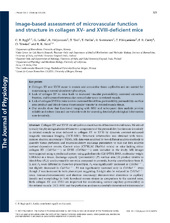| dc.contributor.author | Brekke, Cecilie | en_US |
| dc.contributor.author | Løkka, Guro | en_US |
| dc.contributor.author | Heljäsvaara, Ritva | en_US |
| dc.contributor.author | Taxt, Torfinn | en_US |
| dc.contributor.author | Pavlin, Tina | en_US |
| dc.contributor.author | Sormunen, Raija T. | en_US |
| dc.contributor.author | Pihlajaniemi, Taina | en_US |
| dc.contributor.author | Curry, Fitz-Roy E. | en_US |
| dc.contributor.author | Tenstad, Olav | en_US |
| dc.contributor.author | Reed, Rolf K. | en_US |
| dc.date.accessioned | 2015-09-23T12:32:38Z | |
| dc.date.available | 2015-09-23T12:32:38Z | |
| dc.date.issued | 2014-01 | |
| dc.identifier.issn | 0022-3751 | |
| dc.identifier.uri | https://hdl.handle.net/1956/10517 | |
| dc.description.abstract | Collagen XV and XVIII are ubiquitous constituents of basement membranes. We aimed to study the physiological roles of these two components of the permeability barrier non-invasively in striated muscle in mice deficient in collagen XV or XVIII by dynamic contrast-enhanced magnetic resonance imaging (DCE-MRI). Structural information was obtained with transmission electron microscopy (TEM). MR data were analysed by two different analysis methods to quantify tissue perfusion and microcirculatory exchange parameters to rule out data analysis method-dependent results. Control mice (C57BL/6J Ola/Hsd strain) or mice lacking either collagen XV (Col15a1−/−) or XVIII (Col18a1−/−) were included in the study. MR images were acquired using a preclinical system using gadodiamide (Gd-DTPA-BMA, molecular weight 0.58 kDa) as a tracer. Exchange capacity (permeability (P)–surface area (S) product relative to blood flow (FB)) was increased in test mice compared to controls, but the contributions from P, S, and FB were different in these two phenotypes. FB was significantly increased in Col18a1−/−, but slightly decreased in Col15a1−/−. PS was significantly increased only in Col18a1−/− even though P was increased in both phenotypes suggesting S might also be reduced in Col15a1−/− mice. Immunohistochemistry and electron microscopy demonstrated alterations in capillary density and morphology in both knockout mouse strains in comparison to the control mice. Both collagen XV and XVIII are important for maintaining normal capillary permeability in the striated muscle. DCE-MRI and the perfusion analyses successfully determined microvascular haemodynamic parameters of genetically modified mice and gave results consistent with more invasive methods. | en_US |
| dc.language.iso | eng | eng |
| dc.publisher | Wiley | eng |
| dc.rights | Attribution CC BY | eng |
| dc.rights.uri | http://creativecommons.org/licenses/by/3.0/ | eng |
| dc.title | Image-based assessment of microvascular function and structure in collagen XV- and XVIII-deficient mice | en_US |
| dc.type | Peer reviewed | |
| dc.type | Journal article | |
| dc.date.updated | 2015-07-30T06:59:26Z | |
| dc.description.version | publishedVersion | en_US |
| dc.rights.holder | Copyright 2014 The Authors | |
| dc.identifier.doi | https://doi.org/10.1113/jphysiol.2013.263574 | |
| dc.identifier.cristin | 1158540 | |
| dc.source.journal | Journal of Physiology | |
| dc.source.40 | 592 | |
| dc.source.14 | 2 | |
| dc.source.pagenumber | 325-336 | |
| dc.subject.nsi | VDP::Medisinske fag: 700::Basale medisinske, odontologiske og veterinærmedisinske fag: 710::Medisinsk mikrobiologi : 715 | |
| dc.subject.nsi | VDP::Midical sciences: 700::Basic medical, dental and veterinary sciences: 710::Medical microbiology: 715 | |

